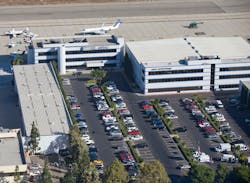General Aviation Airports: A National Asset
What do general aviation airports mean to your community? In California and across the West, which are experiencing the worst fire season in history, general aviation airports are national assets that play an essential role in providing emergency services to devastated communities.
In addition to serving as a versatile fire management tool, fixed- and rotary-wing aircraft are especially important in situations where access is obstructed by damage to existing roads and bridges, harsh terrain or lack of infrastructure. When a disaster strikes, many relief efforts depend on donated business or private aircraft to provide evacuation services or transport urgently needed medical supplies, clothing, blankets, food and water to suffering populations.
This makes small and regional airports across the nation a central hub for first responders and rescue teams, humanitarian aid and emergency air transport. While many individuals appreciate the vital role general aviation aircraft play during times of emergency, few recognize their local airport as a vital economic asset and contributor to the community year-round.
In the wake of the COVID-19 pandemic, it is hard to overlook the importance of local general aviation airports as commercial airlines cut back on service, flights and personnel. According to the U.S. Department of Transportation, there are approximately 5,100 public use airports in the nation that are accessed by general aviation aircraft, compared to approximately 500 that offer commercial airline service. This means that business aviation reaches 10 times the number of U.S. airports than do the airlines. In the current situation, the destinations served by air carriers are expected to continue to decline.
According to the National Business Aviation Association, business aviation contributes $150 billion to U.S. economic output and employs more than 1.2 million people. In addition, general aviation activities reap substantial financial benefits for every state in the nation. Only about three percent of the approximately 15,000 business aircraft registered in the U.S. are flown by Fortune 500 companies, while the remaining 97 percent are operated by a broad cross-section of organizations, including governments, universities, charitable organizations and businesses.
To increase awareness of the essential role that general aviation fulfills, the National Air Transportation Association (NATA) has launched a new initiative called “General Aviation Advancing America.” Through this effort, focused gatherings among key business and community leaders are being held at airports across the nation to discuss how aviation activities in cities and towns support well-paying jobs, economic growth and collaboration that can empower a community during all phases of a crisis.
Another goal of these gatherings is to emphasize the importance of relationships among public airports, private businesses and aircraft operators. There is a critical need to generate ideas on how to best communicate the importance of aviation businesses and the essential services they deliver to airports and their stakeholders. Telling the complete story of general aviation to policymakers, opinion leaders and the public is essential to protecting the entire aviation industry.
Notably, it has been nearly a decade since the Federal Aviation Administration (FAA) conducted a national review of general aviation airports. In 2012, its report entitled “General Aviation Airports: A National Asset” documents an 18-month study of the nearly 3,000 general aviation airports, heliports and seaplane bases identified in the FAA’s National Plan of Integrated Airport Systems.
The FAA’s in-depth analysis aims to educate the public about the pivotal role general aviation airports play in our society, economy and the national aviation system. The study also places general aviation airports into four categories based on their activity levels – national, regional, local and basic – to help capture their diverse functions and economic contributions. In 2014, an in-depth review of the nearly 500 unclassified airports listed in the original study was conducted as a follow-on study.
Overall, these reports document many important aeronautical functions that are economically and effectively supported at general aviation airports, many of which cannot be supported at primary commercial service airports. The categories of flights serving the public interest include:
Emergency Preparedness and Response
- Aeromedical flights
- Law enforcement, national security and border security
- Emergency response
- Aerial firefighting support
- Emergency diversionary airport
- Disaster relief and search and rescue
- Critical federal functions
Critical Community Access
- Remote population and island access
- Air taxi and charter services
- Essential scheduled air cargo service
Other Aviation Specific Functions
- Corporate and self-piloted business flights
- Flight instruction and personal flying
- Charter passenger services
- Aircraft and avionics manufacturing and maintenance
- Aircraft storage
- Aerospace engineering and research
Commercial, industrial and Economic Activities
- Agricultural support
- Aerial surveying and observation
- Low-orbit space launch and landing
- Oil and mineral exploration/survey
- Utility and pipeline control/inspection
- Business executive flight service
- Manufacturing and distribution
- Express delivery service
- Air cargo
Destination and Special Events
- Tourism and access to special events
- Intermodal connections (rail, ship)
- Special aeronautical (skydiving, air shows)
General aviation airports are diverse and their aeronautical functions have evolved over time to meet the specific needs of the communities they serve. As a result, the U.S. has the largest and most diverse system of general aviation airports in the world. Airport-based tenant businesses continue to play a key role in preserving jobs and the economic health of communities, as well as delivering vital services to a broad range of industries that rely on them and the airport for support.
Helping others understand the many benefits of general aviation is essential to protecting the industry, preserving tenant businesses and empowering regional economic growth.
Curt Castagna, president and CEO of Aeroplex/Aerolease Group, is a member of the Los Angeles County Airport Commission, president of the Van Nuys and Long Beach Airport Associations, and board chair of the National Air Transportation Association. A certified private and instrument-rated pilot, he has instructed courses in aviation administration at Cal State Los Angeles for over two decades.
About the Author

Curt Castagna
President and CEO
Curt Castagna, President/CEO of Ascension Group Partners, serves as president and CEO of the National Air Transportation Association, member and past chair of the Los Angeles County Airport Commission, and president of the Van Nuys and Long Beach airport associations. A certified private, seaplane and instrument-rated pilot, he continues to instruct courses in aviation administration at Cypress Community College and Cal State Los Angeles.
